Chapter 14
Practice Test 1: Answers and Explanations
PRACTICE TEST 1 ANSWER KEY

PRACTICE TEST 1 EXPLANATIONS
Section 1—Reading
1. D
Use POE! Although there doesn’t seem to be any animosity, there is no evidence of the townspeople supporting Clym, so eliminate (A). Choice (B) can be eliminated because it is not supported in the passage. Clym’s fame was built over years in his youth, and there is no reason given for why he is not going to return to Paris. You don’t even know for sure whether he will return or not. Choice (C) is not stated in the passage, which mentions Clym telling a Scripture riddle, but this does not mean his upbringing was religious. Choice (D) is correct because the passage states that the only absolute certainty about him was that he would not stand still in the circumstances amid which he was born.
2. A
The answer to question 1 is best supported by (A) because this portion of the passage discusses that something was expected of Clym regardless of whether it was good or bad, and he would not simply stagnate.
3. B
The observer’s eye is being arrested by Clym’s face, which is later described as attractive. This is obviously not a criminal type of arrest, so (A) and (D) can be eliminated. This sentence is discussing an onlooker’s glance being captured by Clym’s features, so (C) doesn’t make sense because nothing is forcing this. Choice (B) is the correct answer.
4. A
Use POE! Choice (B) can be eliminated because there is no support that people are beginning to bore of him. Choice (C) can be eliminated because the passage doesn’t say anything about the state of Clym’s finances or how fancy his lifestyle is. Choice (D) can be eliminated because you don’t know for sure that he never could live up to his renown. You don’t know precisely if the quote was originally about Clym, but it doesn’t matter. The author uses this quote to plant the idea of disappointment. Later in the passage, suspicions continue when a curiosity as to why he stayed on so long arises. You know that Clym went off to London and Paris, but now he is back and for longer than a holiday.
5. B
This paragraph suggests that Clym has stayed in town longer than a normal vacation, which causes curiosity because he is someone who has something being expected of him. These two ideas seem to be at odds with each other, which is best summarized in (B). There is no evidence to support the idea that the townspeople want him to return to Paris or that they are intrusive in his life, so (A) and (C) can be eliminated. The word prove in (D) is too strong because this paragraph doesn’t even discuss awkward spreading of Clym’s fame, so (D) can be eliminated as well. Choice (B) is the correct answer.
6. C
This sentence is contrasting the idea that comes before it, which says that Clym must of necessity have something in him by saying that it is possible his fame owed something to the accidents of his situation. In context, the word accidents means “luck” or “happenstance.” The answer that best summarizes this is (C). Choice (A) is incorrect because no literal crashes are mentioned. Choice (B) is also too literal a definition of accidents and does not relate to luck. Choice (D) plays off the idea of an accident like a car accident, but it is incorrect in this context.
7. B
Use POE! The passage doesn’t say anything about Clym being wealthy or having reputation overseas, so eliminate (A). The passage does mention his facial features but not any sort of tragic circumstances, so eliminate (C). Clym is never said to have any skill as a preacher, so eliminate (D). Only (B) correctly characterizes him because he is known to be famous and a lad of whom something was expected.
8. C
The answer to the previous question is best supported by (C). In these lines, Clym is described as An individual whose fame has spread and therefore must have something in him. None of the other answer choices support this idea of fame and potential.
9. A
The comparison being made in the first paragraph is one of something prosaic (sounds and shapes) becoming attractive and interesting when used in conjunction with others to create language or writing. This relationship is best mirrored in (A). The color yellow by itself on the palette is commonplace, but painted with other colors into something such as a sunrise makes it more appealing. Choice (B) describes two things as equally appealing. Choice (C) is about something not being beautiful until it is understood. Choice (D) is comparing two different types of gems.
10. C
The passage says that the tulip was useless but beautiful. The passage makes no mention of the tulip’s scent, so eliminate (A). Though the tulip is called exotic, the author does not ascribe the flower’s popularity to its exotic botany; eliminate (B). Because (C) mentions the flower’s beauty, (C) is the best answer. The passage specifically states that the tulip had no medicinal qualities, so eliminate (D).
11. D
Only (D) mentions the tulip’s beauty, the answer to the previous question.
12. C
In context, the word pitch refers to the mad embrace of the tulip by the Dutch. Therefore, the correct answer should mean something like “frenzy.” Throw, angle, and promotion mean completely different things, while level can mean “intensity,” which most closely matches the meaning of pitch. Therefore, (C) is correct.
13. B
In context, the word spectacularly emphasizes how very flat, monotonous, and swampy Holland is. Eliminate (A) because the Low Countries are never described as beautiful. Choice (B) is correct because the Dutch landscape is described as monotonous. Get rid of (C) because there is no tone of irony in the passage. Eliminate (D) because the efforts to make the Low Countries beautiful are not mentioned until later in the paragraph.
14. A
The fourth paragraph describes the popularity of botany in 17th-century Holland. This matches (A). Choice (B) is incorrect because there is no mention of a baseball field. Choice (C) contradicts the passage, which says that Dutch botanists were extremely famous. Choice (D) is incorrect because there is nothing that says the Dutch obsession was unusually strong.
15. B
The passage states that Dutch gardens were used to make statements about one’s sophistication and wealth. Choice (A) is incorrect because it takes an overly literal interpretation of the statement that the Dutch saw their gardens as being like jewel boxes. Choice (B) is correct because the passage states that flowers were a status symbol for the Dutch. Choice (C) says that all Dutch gardens were full of exotic and expensive flowers, which is not supported by the text. Choice (D) says that Dutch gardens had only one flower in them; this is also not supported by the text, which states only that that one flower could make a powerful statement.
16. B
The answer to the previous question states that the flowers were used as a status symbol for the Dutch. Choice (A) is incorrect because it emphasizes how tiny and prized Dutch gardens were, but it does not mention social status. Choice (B) is correct because it states “To make such statements—about one’s sophistication, about one’s wealth—has always been one of the reasons people plant gardens,” which matches question 15. Choices (C) and (D) are incorrect because they do not discuss status or wealth in relation to the flower.
17. A
In context, utilitarian means “useful.” Only practical matches this meaning. The best answer is (A).
18. D
The passage contrasts the useful rose and lily with the useless tulip. There is no indication of the price of roses or lilies; therefore, eliminate (A). There is no indication of whether or not roses or lilies are exotic, so eliminate (B). There is no indication that roses and lilies are not beautiful, so eliminate (C). Choice (D) is supported by the text’s claim that roses and lilies were originally prized for how useful they are, but that the tulip is extraordinarily useless.
19. B
The blurb indicates that the author of this passage was a mill-worker, writer, and social activist and played an important role in the labor and women’s suffrage movements. Therefore, disinterested would not describe Robinson’s perspective, so (A) can be eliminated. Choice (B) is a good match because she is a social activist, and the final sentence of the passage expresses her strong belief that many men…were helped to an education by the wages of the early millgirls. Choice (C) is incorrect because Robinson never expresses anger nor is she trying to cause trouble. Choice (D) is incorrect because carefree does not capture the way she proudly and positively portrays the hard work of the women she describes in this passage. Therefore, (B) is the best answer.
20. D
In the first paragraph, the author states that women and troops of young girls came from all over to take advantage of the cotton mills that were looking for help and the high wages that were offered to all classes of work-people. Therefore, women moved to Lowell because they wanted these jobs with high wages. Choices (A) and (B) are incorrect because the author does not discuss the climate or any vacation time in this paragraph. Choice (C) is tempting because the women and girls were coming from distant towns, different parts of New England, and Canada. However, the author does cite working in a diverse atmosphere as the reason for them wanting to work in the cotton mills. This leaves (D). Even if you’re unsure about what remuneration means, you can confidently pick (D) because of POE. However, if you do know what remuneration means (money paid for work or service), then (D) is clearly the correct answer.
21. C
This question is really asking, “Why does the author mention the working conditions of England and France?” In the second paragraph, the author states that, at the time, being a factory girl was the lowest employment position a woman could hold. This view—that working as a millgirl was a degrading occupation—was established due to the treatment of women in factories in countries like England and France. In order to overcome this prejudice, high wages were offered to entice women to work as millgirls. Thus, the author refers to working conditions in England and France to illustrate how the working conditions at the Lowell mills would be different. Choice (C) is a good match. Eliminate (A) and (D) because the author says exactly the opposite. The conditions in these two European countries were neither superior nor were they a model that the author was advocating for the United States. The author gave an example of working conditions elsewhere during this time period but did not provide a historical overview of the Industrial Revolution, so (B) is incorrect. The best answer is (C).
22. C
The answer to the previous question was that the working conditions in England and France were mentioned in order to draw a contrast between those conditions and the conditions promised to workers in the Lowell mills. Because being a factory girl was a degrading occupation, the corporations in Lowell needed a way to convince women to take these positions, so they offered high wages. The lines that best support this answer are lines 20–24, (C). Eliminate (A) and (B) because neither choice offers a contrast between the conditions in European factories to those in the Lowell mills. Choice (D) provides information about working conditions only in the Lowell mills but provides no information about the working conditions in England and France. Therefore, (C) is the best answer.
23. A
The corporations were trying to find ways to overcome a prejudice by offering them high wages to work in a role that had a negative association still clinging to this degrading occupation. Work that is degrading would cause humiliation or shame, so opprobrium means something similar to “shame.” Eliminate (B) and (C) because those choices have positive meanings. Choice (D) is a possibility because trauma (a disturbing or distressing event) could cause shame; however, the word itself does not mean “shame,” so this answer should be eliminated. Choice (A) is disgrace, which is a synonym for “shame.” Therefore, the best answer is (A).
24. D
In the third paragraph, the author describes the youngest girls employed at the Lowell mills. While they might have some free time, they were responsible for taking off the full bobbins from the spinning-frames and replacing them with empty ones, so they did not have “complete freedom,” which makes (A) incorrect. There is no mention of the youngest girls spending their time in an educational setting in this paragraph or the passage, so (B) is not correct. Choice (C) is incorrect because the doffers were aged under 10 years old. This leaves (D), which can be supported by information earlier in the third paragraph. In lines 31–34, the author lists activities that the girls might occupy their free time with when they weren’t replacing empty bobbins. The correct answer is (D).
25. B
The answer to the previous question was that the youngest girls were afforded more leisure time than were the older girls and adult women. The best evidence for this answer is found in lines 31–34, (B). Choice (A) is incorrect because these lines describe only what the youngest girls were called and what they did in the mills, not that they had more leisure time than the older girls and women. Choice (C) is incorrect because those lines are not specifically referring to the youngest girls. Choice (D) includes lines that make no mention of the youngest girls working in the mills, so it cannot provide supporting evidence for the previous question. The correct answer is (B).
26. A
The table provided in this passage shows the daily schedule for the workers at the Lowell Mills in 1851. Choice (A) is a good match because this answer references the amount of time the women were required to be at the mills, and the table contains the daily schedule for the year. The table does not indicate that there are five corporations or how the millgirls spent their wages, so eliminate (B) and (C). Choice (D) is incorrect because the daily schedule provided in the table in no way connects to (D)’s claim. Choice (A) is the best answer.
27. C
In the last paragraph, the author explains that the main incentive for women who wanted these jobs was to secure the means of education for some male member of the family. The money for the men’s education was the most important reason to take these jobs. In context, prevailing means something similar to “main” or “most important.” Eliminate (A), (B), and (D) because they do not mean the same thing as “main” or “most important.” Predominant does mean the same thing as “main” or “most important,” so (C) is the best answer.
28. B
The fifth paragraph discusses the idea that the money the millgirls earned often went to secure the means of education for some male member of the family. Lines 56–59 indicate that the importance of a college education for the men was a dominant thought in the minds of many of the millgirls. The author also gives examples of women who provided men the means to earn their education. The author never indicates that the women were contemptuous (scornful) of the men, so (A) should be eliminated. Choice (B) is a good match because it was common for the women to use their earnings to pay for their male relatives’ education, and the author gives examples of women who did so. Choice (C) could be true, but that claim is never directly made in the passage, and more importantly, it is not the main idea of the fifth paragraph. Choice (D) is incorrect because the women were not earning money for their daughters; they were using the money to pay for the male relatives’ education. Therefore, the best answer is (B).
29. D
The first paragraph mentions titanium’s ability to impart white coloring and brightness to objects. Lines 5–7 state that the very high refractive index of titanium dioxide means that it has high light-scattering ability. The phrase as a result lets the reader know that this quality is what allows titanium dioxide to impart whiteness, opacity, and brightness to many products. While the authors do state in the first paragraph that titanium is highly resistant to corrosion, (A), and 45% lighter than steel, (B), these facts are not mentioned in relation to titanium’s ability to impart whiteness and brightness to objects. Choice (C) is mentioned in lines 40–41, but there is no reference to whiteness or brightness in this paragraph. Therefore, the correct answer is (D).
30. A
The answer to the previous question was that titanium’s high refractive index accounts for its ability to impart white coloring and brightness to objects. Lines 5–8 directly state this, so (A) provides the best evidence for the answer to the previous question and is the correct answer. Eliminate (B) and (C) because they do not refer to titanium’s ability to impart whiteness and brightness to objects. The fact titanium is naturally abundant does not account for its ability to impart whiteness or brightness to objects, so eliminate (D).
31. A
Matthew Hunter was the first person to isolate titanium metal. However, because the process was so difficult, the metal was considered a laboratory curiosity. Once William Kroll developed a method to produce the metal in commercial quantities, titanium was used more widely. In context, the word curiosity means something similar to “peculiar” or “unusual” because, at first, it could not be made into commercial quantities due to the difficult isolation process—it was something found only in a laboratory. Choices (C) and (D) do not mean “peculiar” or “unusual,” so eliminate them. Choice (B) is often associated with curiosity; however, it does not match “unusual” and does not make sense in context because the metal itself cannot be inquisitive, so eliminate (B). Only oddity in (A) has a meaning similar to “peculiar” or “unusual” and is the best answer.
32. C
Use POE! The table presents the percentage of titanium dioxide and the distribution by industry for 2011 and 2012. Choice (A) does not contain any information that is listed in the table, so get rid of (A). The table does not include information about opacity and brightness, so eliminate (B). Choice (C) could work because the products listed are found in the table and would account for more than 75% of titanium dioxide’s distribution, which supports the idea that most titanium dioxide is used in these products. The table does not provide information on quality or weight, so eliminate (D). The best answer is (C).
33. B
Lines 26–28 mention that the paint industry began using titanium dioxide because of the environmental hazards associated with lead paint. Then, lines 28–31 list several products that titanium is used in for coloring because it is relatively inert. Lines 36–39 mention that titanium is also used in biological implants because the metal is nonreactive in the human body. The authors do support the idea that titanium is safe for human use and give specific examples and reasons, so (C) and (D) can be eliminated. Choice (A) is incorrect because it does not provide the correct reasons/examples to answer this question. The correct answer is (B) because it includes the information from lines 28–31 and lines 36–39.
34. C
The text says that the corrosion resistance of titanium metal and its alloys make them particularly valuable. Therefore, resistance must mean something like “prevention.” Safeguard means “protect,” so eliminate (A). Support means “help” or “hold up,” so eliminate (B). Blocking matches “prevention,” so keep (C). Struggle means “fight” or “effort,” so eliminate (D). The correct answer is (C).
35. C
The authors mention steel and aluminum in the first paragraph. Titanium is compared with steel—It is as strong as steel but 45 percent lighter—and aluminum—it is twice as strong as aluminum but only 60 percent heavier. So the authors are comparing the three metals to give the reader a sense of titanium’s strength and weight compared with those qualities in steel and aluminum. Choice (C) is a good match. The authors discuss titanium’s ability to impart brightness and opacity to objects later in this paragraph but not compared in any way to steel or aluminum, so eliminate (A). While titanium is stronger than aluminum, it is only as strong as steel, so titanium is not stronger than all other metals. Eliminate (B). The natural abundance of titanium is never mentioned in this paragraph. When it is mentioned later in the passage, steel and aluminum are not, so eliminate (D). Therefore, the best answer is (C).
36. A
In lines 52–53, the authors state that rutile has a very high index of refraction and is the most desirable in the pigment industry. Because rutile is the most desirable form of titanium for the pigment industry, it is likely the most useful for manufacturing paint products, (A). Ilmenite accounts for 90% of the world’s titanium, but the authors do not state that it is used by the pigment industry or for paint products; eliminate (B). The specific economic importance of anatase is never directly stated, so eliminate (C). Titanium metal was mentioned earlier in the passage as being useful for biological implants and to the aerospace industry, not to the pigment industry; eliminate (D). The correct answer is (A).
37. B
Because the answer to the previous question was rutile, (B), lines 50–53, would best support this answer. The lines in (A) make no reference to rutile. Choices (C) and (D) discuss ilmenite, which is not the correct answer to the previous question. Therefore, the answer that provides the best evidence for the answer to the previous question is (B).
38. D
This question asks what can be inferred about mind wandering in Passage 1. Notice that this is the first question in a paired set, so it can be done in tandem with question 39. Consider the answers to question 39 first. The lines for (39A) simply describe the experiment of Dr. Axelrod, but don’t give any specifics about mind wandering. Eliminate (39A). The lines for (39B) continue with a direct description of the experiment. Again, there is no discussion of mind wandering, so these lines don’t support any of the answers for question 38. Eliminate (39B). The lines for (39C) say that experiment showed that frontal lobes play a causal role in the production of mind wandering behavior. These lines support (38D), so draw a line connecting those two answers. The lines for (39D) do not mention mind wandering, so eliminate that answer. Without support from question 39, (38A), (38B), and (38C) can be eliminated. The correct answers are (38D) and (39C).
39. C
(See explanation above)
40. B
This question asks what the word stem most nearly means in line 26. Go back to the text, find the word stem, and cross it out. Then read the window carefully, using context clues to determine another word that would fit in the text. The text says that Bar believes that this surprising result might stem from the convergence. Therefore, stem must mean something like “come from.” Branch means “divide from,” so eliminate (A). Originate means “come from,” so keep (B). Contain means “hold in,” so eliminate (C). Restrain means “hold back,” so eliminate (D). The correct answer is (B).
41. D
This question asks why the author mentions “a painful procedure in a doctor’s office.” Carefully read the window to figure out why the author would use that phrase. The author mentions that increasing the amount’of daydreaming we do’can be beneficial. She then goes on to say that the doctor’s visit can be made less distressing by visualizations of soothing scenes. The mention of the doctor’s office is included as an example of her previous statement. Eliminate any answers that aren’t consistent with this prediction. Choice (A) might initially look attractive because the author does provide an example, but there’s no evidence the example is a personal example. Additionally, the concept is not an abstract one. Eliminate (A). Choice (B) can be eliminated because the author is not attempting to trigger a’memory. She is simply using the doctor’s office as an example. Eliminate (B). Choice (C) can be eliminated because it has nothing to do with the window or the prediction. Choice (D) is a clear paraphrase of the prediction and the correct answer.
42. A
This question asks what the word caught most nearly means in line 63. Go back to the text, find the word caught, and cross it out. Then read the window carefully, using context clues to determine another word that would fit in the text. The text says that the researchers asked 122 undergraduates at the University of British Columbia to read a children’s story and press a button each time they caught themselves tuning out. The missing word must mean something like “noticed” or “became aware of.” Detected means “noticed,” so keep (A). Entangled means “intertwined” or “ensnared,” so eliminate (B). Developed means “to make more advanced,” so eliminate (C). Overtook means “to move ahead of,” so eliminate (D). Although entangled and overtook are both possible definitions of caught, neither of them is consistent with the prediction. The correct answer is (A).
43. C
This question asks what the passage most clearly suggests about daydreaming. Notice that this is the first question in a paired set, so it can be done in tandem with question 44. Look at the answers for question 44 first. The lines for (44A) say that increasing the amount of…daydreaming…can be beneficial. These lines don’t support any of the answers for question 43, so eliminate (44A). The lines for (44B) simply define daydreaming as tuning out or off-task thinking. These lines don’t support any of the answers for question 43, so eliminate (44B). Choice (44C) says that people who notice when they’re [tuning out]…seem to be the most creative. These lines support (43C), so draw a line connecting these two answers. Choice (44D) mentions a flash of insight about an unsolved problem. These lines might initially seem to support (43A), but there’s no indication in the text that daydreaming is the only way to solve a difficult problem. Eliminate (44D). Without support from question 44, (43A), (43B), and (43D) can be eliminated. The correct answers are (43C) and (44C).
44. C
(See explanation above)
45. C
This question asks for a point made in Passage 1, but not in Passage 2. Since this is a question about both passages, it should be done after the questions about an individual passage. Passage 1 does not mention a correlation between mind wandering and intelligence, so eliminate (A). Passage 2 mentions everyday activities (reading, visit to the doctor’s office), so eliminate (B). Passage 1 mentions the frontal lobes and occipital cortex when discussing the study by Dr. Vadim Axelrod, but there are no brain regions mentioned in Passage 2, so keep (C). Passage 2 discusses details about a study in which people who engaged in a mildly demanding task, such as reading, during a break from, say, a visual assignment, such as the hat-rack problem—in which participants have to construct a sturdy hat rack using two boards and a clamp—did better on that problem than those who did nothing at all. Eliminate (D). The correct answer is (C).
46. B
This question asks for something the authors of Passage 1 and Passage 2 would both agree with. Since this is a question about both passages, it should be done after the questions about an individual passage. While Passage 1 says that our study’s external stimulation increased the incidence of mind wandering, it does not say it’s inevitable, which is too extreme, so eliminate (A). Passage 1 says that mind wandering did not reduce the subjects’ ability to complete the task and it caused task performance to become slightly improved and Passage 2 says that mind wandering could also explain [a] flash of insight, so keep (B). Passage 2 does not mention passion, so eliminate (C). Passage 1 does not talk about intelligent people, so eliminate (D). The correct answer is (B).
47. D
This question asks which lines in Passage 2 most directly corroborate the conclusion about external stimulation on concentration as presented in Passage 1. Look for a conclusion about external stimulation in Passage 1, and then check each set of lines in the answer choices. The last paragraph in Passage 1 says that external stimulation increased the incidence of mind wandering and the external stimulation actually enhanced the subjects’ cognitive capacity. The lines for (A) say that daydreaming can help relieve stressful experiences, but there is no connection to cognitive capacity. Eliminate (A). The lines for (B) simply describe an experiment, but don’t address the results of the experiment. Eliminate (B). The lines for (C) say that mind wandering is important, but meta-awareness is also needed. There is no mention of cognitive capacity, so eliminate (C). The lines for (D) say that researchers found that people who engaged in a mildly demanding task, such as reading…did better on that problem than those who did nothing at all. This supports the idea that external stimulation enhanced cognitive capacity. The correct answer is (D).
Section 2—Writing and Language
1. B
The phrase quite the contrary is meant to emphasize that tuition costs are not only not decreasing, they are increasing. The answer that best matches this is (B). Choice (A) is not supported by the text—the author does not mention his or her tuition costs. Choice (C) goes too far; although the phrase does indicate that tuition costs have increased, it does not support the claim that it is too expensive for many who wish to attend college. There is no indication elsewhere in the paragraph that tuition has increased, so (D) is not correct. The best answer is (B).
2. A
The sentence in question states that Business majors are over 10% more likely to have jobs that require college degrees…than are Humanities majors. According to the graphic, this statement is true. Business majors holding jobs that require college degrees are counted at 55.6%, while Humanities majors holding jobs that require college degrees are counted at 45.4%. Choice (B) is incorrect; more than 50% of Area Studies majors are employed in both jobs that do and do not require a college degree. Choice (C) is not supported by the graphic, as it demonstrates only the current rate of employment for certain areas of studies by college degree requirement; it does not indicate future trends. Choice (D) is not relevant to the point being made in the paragraph. Also, because the focus is on specific types of majors that are more likely to lead to employment for graduates, (D) is too vague. The only answer that is supported by the graphic and expresses this point is (A).
3. C
The underlined portion there have been refers to the sharp rise later in the sentence. Because a sharp rise is a singular subject, it needs to have a singular verb. Because both (A) and (B) are plural (and they have the exact same meaning), they can be eliminated. Choice (D) corrects the agreement error between the subject and verb but includes an apostrophe error with “they’re.” The correct answer is (C), as it corrects the agreement error with the word “has” and does not contain any additional errors.
4. B
The first sentence of this paragraph describes when the phrase “supply-chain management” was introduced. The second sentence describes the progression of how that term and practice became defined. The choice that stresses this progression over time is (B), as it clearly establishes a timeline by referencing a specific era. Choice (C) references time but is too vague. Choices (A) and (D) are both awkward and are not related to the progression of the term. The best answer is (B).
5. D
In this sentence, the author is introducing an example to support his or her argument. The idiomatic phrase used should be “For instance.” The only choice that contains the correct phrasing is (D).
6. C
Expand out the contraction. They’re is the same as they are, which is not correct in this context. Eliminate (A). The remaining answer choices contain both plural and singular pronouns. Because the noun earlier in the sentence that is being replaced is factory, which is singular, a singular pronoun is needed. Eliminate (D) as well. Expanding (B) results in “it is,” which is incorrect. The its in (C) is singular and demonstrates the factory’s possession of the road-ready vehicles, so it is the correct answer.
7. B
As it is currently written, the sentence is very awkward. Because the introductory phrase is describing the process of supply-chain management, that process needs to be placed closely to that phrase in the sentence. Only (B) does this. Choice (C) has natural resources being described by the introductory phrase and is also awkward. Choice (D) has the life cycle of the car being described by the introductory phrase rather than the process and would create a comma splice. Choice (B) is the best answer.
8. D
The central idea of this paragraph is the multi-step process that supply-chain management goes through. The most effective conclusion to the paragraph will relate to that process in some way or other. Choice (A) refers to making personal profit, which is not directly related to the process. Choice (B) refers to a prince, which does not make sense with the topic of this paragraph. Choice (C) indicates that the topic of the paragraph is interesting but does not refer to it directly. Rather, it could refer back to a number of singular pronouns used in the previous sentence. Because this answer would create ambiguity, (C) is not a very effective conclusion. Choice (D) directly refers to the supply chain mentioned in the paragraph, which makes it the most effective conclusion to this paragraph.
9. A
Punctuation is what is changing in the answer choices. As the sentence is written in the passage, a complete idea comes before the single dash. As long as a complete idea comes before a single dash, it is grammatically correct, regardless of what comes after. Keep (A). Because the second part of the sentence is not a complete idea, neither a period nor a semicolon can be used, so eliminate both (B) and (C). In (D), the use of the single dash is grammatically correct, but the comma is unnecessary. Therefore, the best answer is (A).
10. A
Two commas should be used around unnecessary information. Because the phrase like any college major is not necessary in this sentence, the two commas are correct as written. Eliminate (B) and (D). Choice (C) should be eliminated because it adds an extra comma after like, which is not needed. Therefore, the correct answer is (A).
11. C
The additional sentence refers to aspects of manufacturing a car. Because the only parts of the passage that discussed car manufacturing are paragraphs 2 and 3, eliminate (A). Choice (B) places the discussion of different aspects of car manufacturing before the example of car manufacturing is mentioned, so it is not the best answer. Choice (C) places the additional sentence after a reference to hundreds or thousands of other, smaller processes and before Each of these has to be…. Because there is nothing mentioned in the first sentence of paragraph 3 that Each is clearly referring to, the additional sentence not only connects these two ideas but also corrects that ambiguity error. Choice (D) would place the additional sentence later in the paragraph, where the discussion is focused on the selling of the car rather than the manufacturing of it. The best answer is (C).
12. C
The central idea of the first paragraph is who Millard Fillmore is and the background of his presidency. Because the addition is referring to a completely unrelated president who took office years after Fillmore and does not relate to Fillmore or his presidency directly, the best answer is (C). Choice (D) is not supported by the text. Choices (A) and (B) are incorrect because the addition would take the focus away from the topic being discussed rather than bring any benefit to the reader.
13. D
As written, the second part of the sentence does not support the first part, which indicates that Fillmore’s presidency marked the end of the Whig Party’s popularity in the United States. Currently, the sentence is about wigs, not the Whig Party. Eliminate (A). Of the remaining choices, the only one that references the lack of the Whig Party in presidential politics is (D). Choice (B) refers to England, which is not relevant. Choice (C) focuses on Fillmore rather than the absence of the Whig Party.
14. D
The pronoun they in the underlined portion is plural. The previous sentence mentions that the Whig party fell out of national politics, so they is referring to the Whig Party, which is singular. Eliminate (A) and (B) because both contain plural pronouns. Between (C) and (D), only (D) clearly indicates what noun is being discussed and is therefore the correct answer.
15. D
Because there is nothing grammatically incorrect with any of the answer choices, the most concise choice that maintains the meaning of the sentence will be the best answer. Choices (A), (B), and (C) all contain superfluous information. The most concise answer is (D).
16. B
This sentence is discussing the growing relationship between the United States and Japan. The underlined portion is referring to the previous approach taken by Japan to foreign relations. Japan’s approach would be better described by a noun rather than a verb, so (A) is incorrect. Itself is redundant in (C); the sentence refers to Japan’s own history of isolation. Choice (D) is both wordy and ambiguous; the word nation could refer to either of the nations listed at the beginning of the sentence. The most concise and grammatically correct answer is (B).
17. A
The second part of this sentence states that the inspiration led Fillmore and others to try to open relations with Japan. The word inspiration should therefore refer to a similar instance of this happening. Choice (A) gives the example of the British and Chinese opening relations, which is similar to what happened with the United States and Japan. Choice (B) refers to an aspect only of American life, not two countries increasing relations. Similarly, (C) refers to aspects only of Japan, so it too can be eliminated. Choice (D) is completely off topic, discussing conflicts that would come later in history rather than an opening up of relations. The best answer is (A).
18. C
The sentence discusses slavery as a national problem. As written, the phrase the whole United States is redundant with the word national. Eliminate (A). Choice (B) is awkward and contains redundant language with the word everyone. The sentence refers to non-slave states, which indicates the different approaches taken by the North and the South toward slavery. Choice (C) indicates the shift that was made by Fillmore to making slavery a national concern, rather than just a southern one. As there is no evidence that slavery was an international concern, (D) cannot be correct. The best answer is (C).
19. B
This question is testing verb tense. Because both the non-underlined portion of the sentence and the underlined portion are discussing how the Fugitive Slave Act worked when it was enacted, both portions should be in the past tense. Choice (A) should be eliminated because it uses the future tense. Choice (C) is in the present tense and can also be eliminated. Choice (D) incorrectly uses the word of instead of have after could and should be eliminated. The only answer choice that correctly contains the past tense is (B).
20. C
The answer choices contain various conjunctions, which are meant to link ideas. Since STOP punctuation is used in the answer choices, use the Vertical Line Test. Both ideas are complete, so (A) and (B) should be eliminated since nevertheless and therefore are not FANBOYS (a semicolon would be needed in place of the first comma to be correct punctuation). The difference between (C) and (D) is the type of FANBOYS used. The first part of the sentence discusses the negative side of the Fugitive Slave Act, and the second part of the sentence discusses how it helped spur—or cause—the Civil War. Therefore, a word that indicates a similarity in thought should be used, which makes (C) the best answer.
21. B
The word forever is not accurate, as civil rights began to be addressed in the mid-20th century in the United States. Furthermore, forever and eternity are synonyms. Both (A) and (C) cannot be correct, so eliminate them. Between (B) and (D), (B) is the factually accurate and less opinionated choice, whereas (D) is informal and doesn’t match the academic tone of this passage (nor does the author state his or her personal opinion about how long civil rights were held back). Choice (B) is the correct answer.
22. A
Because STOP punctuation appears in the answer choices, use the Vertical Line Test. Because the part before the punctuation is incomplete and the part after the punctuation is incomplete, (B) and (C) can be eliminated. Choice (D) adds unnecessary commas around uniquely and after position, so this choice is incorrect. This leaves (A), which correctly places commas around even in its worst form and is therefore the correct answer.
23. D
It is unclear what the phrase that way at the beginning of the sentence is referring to. Choice (B) switches from that way to “those,” which does not make anything clearer in the sentence. Choice (C) replaces that way with “genres.” Although “genres” is more specific than (A) and (B), it does not refer to any specific type or types and so is still highly vague. Choice (D) provides the most detailed answer “the ‘gangster’ genre,” which not only makes the underlined portion clearer, but also matches the topic of the paragraph and passage. Therefore, the best answer is (D).
24. A
This question is testing punctuation. The first part of the sentence is an incomplete idea, while the second part is a complete idea. Because a period can link only two complete ideas, (B) cannot be correct. Also, because a complete idea must come before a colon, (D) is wrong. Compare (A) and (C). Because the first part of the sentence constitutes an introductory phrase, a comma should follow the phrase. Choice (A) is the best answer.
25. B
Pay attention to where there is a shift in the paragraph that seems out of place. The first two sentences give a quote from a film director about American film, while the remainder of the paragraph discusses American literature. As this shift comes between sentences 2 and 3, moving sentence 4 between those two would provide a link between the discussion of American film and literary genres. All other answer choices place this sentence between sentences discussing American literature, which do not need to be linked. The correct answer is (B).
26. C
The second paragraph discusses the background and work of Ross Macdonald. The best introduction to this paragraph is one that is focused on Ross Macdonald specifically. Eliminate (A) and (B), which are focused on different authors. Choice (C) introduces Ross Macdonald, and therefore the subject of the paragraph. Choice (D) does not mention authors at all but rather is merely negative about writing in general. The best answer is (C).
27. C
The answer choices are switching which “wh” word is used: “when,” “which,” and “where.” When is used to refer to time; which is used to refer to things other than people, places, and time; and where is used to refer to places. In this sentence, the thing being referred to is University of Michigan. Because the University of Michigan is a place, the correct answer should have “where.” Choice (C) is the correct answer.
28. A
The first part of the sentence discusses the two different directions it appeared that Millar was being pulled in, so the best choice to maintain the focus of the sentence will relate that topic. As written, the underlined portion gives an example of those two directions. Choice (B) discusses the most famous work of Coleridge, which does not maintain the focus of the sentence since the sentence is about Millar. Choice (C) mentions both movies and books, but there is no indication in this sentence or paragraph that Millar was at all involved with movies. Choice (D) discusses Millar’s preference between two different writers, but the authors are not directions he was being pulled in. The only answer that maintains the focus of this sentence is (A).
29. D
The latter part of the sentence refers to Macdonald’s work as separate from that of his “pulp” contemporaries, so the correct answer must mean the opposite of “lowly” or “cheap.” Superciliousness means “haughtily disdainful.” This is not the opposite of “lowly,” so eliminate (A). Smartness can mean “cleverness” or “sassiness.” Cleverness might work, so keep (B). Know-how means “practical skill,” which is quite casual and not exactly the opposite of “lowly,” so eliminate (C). Sophistication means “educated” or “refinement.” This is the opposite of “low” or “cheap,” so keep (D). The rest of the paragraph talks about Millar studying literature, being engaged’with ideas, and being able to get inside the heads of his characters. These ideas are more consistent with sophistication than smartness, so eliminate (B). The correct answer is (D).
30. B
Based on the answer choices, this question is testing apostrophe usage. The text refers to the text of Macdonald, which indicates possession, so eliminate (A). Because Macdonald does not end in an “s,” eliminate (C) and (D). To show possession, an apostrophe + “s” should be added to the end of the name. The only choice that contains this correct construction is (B).
31. D
As written, the underlined portion contains a noun agreement error. Many people cannot have a single motivation between them all. Eliminate (A). Choice (B) repeats this error, as “those” is plural and “motivation” is singular. Choice (C) corrects the agreement error by replacing people with “someone,” but this creates a new agreement error with the murders earlier in the sentence. Choice (D) correctly addresses the noun agreement error by retaining “people” and changing “motivation” to “motivations,” while not creating any new errors.
32. A
The sentence contains a list: murders, thefts, and kidnappings. All items in a list must be separated by a comma. As there is a comma after thefts in the underlined portion, this sentence is correct as written. Choice (B) omits the comma after thefts, which is incorrect (remember to include the comma before the word “and”). Choice (C) omits the comma after thefts but includes a comma after and, which is also incorrect. Choice (D) adds a comma after the last item in the list kidnapping, so it is also incorrect.
33. C
The current placement of the underlined phrase creates an error since the underlined portion separates the correct idiomatic phrase: Following in the footsteps of…. Eliminate (A). Choice (B) creates a sentence that sounds as though Hammett and Chandler are literally walking toward the detective novel; eliminate (B). Choice (D) does not make sense, as humans are not anything to the detective novel. Only (C) expresses the author’s intended meaning—that it is Macdonald who is bringing something to the detective novel.
34. B
There are verb changes in the answer choices, so the first thing to do is to check if the subject and verb are consistent. The subject earlier in the sentence is the scientific community, which is singular. The verb in the underlined portion is do, which is plural. Eliminate both (A) and (C). Choices (B) and (D) both correct the subject-verb agreement error with “does” but contain different pronouns. Because the scientific community is singular, it must be replaced by a singular pronoun. Because (D) contains “they,” which is plural, it can be eliminated. The correct answer is (B).
35. D
Choices (A), (B), and (C) are all very similar as they include extraneous words. Choice (D) is the most concise answer which also maintains the meaning of the sentence. Therefore, (D) is the best answer.
36. C
There are pronoun and noun changes in the answer choices, so the first thing to do is check what noun these pronouns are replacing. There is some ambiguity in the passage as to the original word, so using a noun is the safer choice. Choices (B) and (D) can be eliminated. Resources makes sense in the context of the passage, while resourcefulness does not. Choice (C) is the correct answer.
37. A
This paragraph ends by mentioning a problem: that these new resources will not cure us fully of energy dependency. The next paragraph introduces a solution to the problem: “asteroid mining” in space. To conclude this paragraph and introduce the next paragraph, the best choice will connect these two ideas. Choice (A) is a good match. Choices (B) and (C) can be eliminated because neither answer mentions space. Choice (D) can be eliminated because it doesn’t reference the problem discussed in the first paragraph. Therefore, the best answer is (A).
38. B
The previous sentence refers to a new, and currently hypothetical, solution. The latter part of the sentence with the underlined portion says the method is exactly what it sounds like, and this is contrasted to how it may sound. The underlined portion must mean something like “weird” or “unusual.” Wonderful means “amazing,” which is not consistent. Eliminate (A). Outlandish means “strange.” This is consistent, so keep (B). Wacky also means “strange,” but it is more casual than “outlandish.” Eliminate (C). Idiosyncratic means “a peculiarity of temperament” and is generally used to describe people. This is not consistent, so eliminate (D). The correct answer is (B).
39. A
Compare the answer choices with the provided graphic. Choice (A) is true based on the graph; new nickel discoveries in 2009 were under 1,000 mt, while new nickel discoveries in 1999 were over 2,000 mt. Choice (B) is incorrect; sulfide production was consistently higher than laterite production from 1998 to 2009. Choice (C) is also incorrect, as total nickel production was lower than the three-year average of total nickel in new discoveries from 1998 to 2004, 2006, and 2008. Choice (D) is also incorrect; according to the graphic, the total nickel found since 1998 has fluctuated over time. The only possible answer is (A).
40. C
The point of the underlined portion of the sentence is that the ship will not need to restock supplies. The most concise way of saying this while maintaining the meaning of the sentence is (C), resupplying. Choices (A), (B), and (D) all say the same thing but are wordier.
41. D
The underlined portion refers to both space travel and exploration, but that is not clear as the sentence is currently written. Choices (A), (B), and (C) are all ambiguous; they do not directly refer to space travel and exploration, so none completes the comparison being made. Choice (D) corrects this error by including the pronoun “they” to refer to the subjects earlier in the sentence, which completes the comparison, making (D) the best answer.
42. B
The answer choices contain changes in punctuation. Using the Vertical Line Test, it is apparent that both the first part and the second part of the sentence are complete ideas. Because a comma by itself cannot link two complete ideas together, (A) and (C) are incorrect. Two complete ideas also cannot be linked without punctuation, so (D) is incorrect. Because two complete ideas can be linked by a semicolon, (B) is the correct answer.
43. A
There are apostrophes in the answer choices, so check for the need of an apostrophe first. The word its refers to the Earth, which is correct without the apostrophe (it’s is the contraction form of “it is”), so (C) can be eliminated. Because the Earth is a singular object, (B) can be eliminated as it is a plural pronoun. Because there is no reason to change from “it” to “one” when referring to the Earth, eliminate (D) and choose (A).
44. C
The claim in the previous statement focuses on the belief that the cost of asteroid mining is far greater than the worth of what is being mined. The question asks for an addition that best supports this claim, so eliminate any answer choices that do not relate to this topic. Choice (B) is focused on the skill of astronauts, not on the cost of asteroid mining. Choice (D) is too general of a statement and does not relate specifically to the cost of asteroid mining. Choice (A) refers to money by noting the types of funding NASA receives but does not specifically relate that funding to asteroid mining. Choice (C) brings up the exorbitant costs of “these expeditions,” which is a direct reference to the mining in the previous sentence. Therefore, (C) is the only answer that supports the previous sentence.
Section 3—Math (No Calculator)
1. A
Use POE to eliminate (C) because the equation in (C) is a straight line. Remember the rules of graph transformations. If the number is inside the parentheses, the graph moves left or right in the opposite direction of the sign. In this case, the graph has been moved 3 units in the positive direction and therefore the correct answer is (A). An alternate way to approach this question is to plug in the point (0, 3) into each of the equations to see which equation works.
2. D
The equation of a line is y = mx + b where m stands for slope and b stands for the y-intercept. In the given equation the slope is a positive 3. Use POE to eliminate (B) and (C) since both of these lines have a negative slope. According to the question, the y-intercept is negative. Use this information to eliminate (A), which has a positive y-intercept. The correct answer is (D).
3. D
Whenever there are variables in the question and numbers in the answers think Plugging In the Answers. Start with (B). If x = 5, then the equation becomes 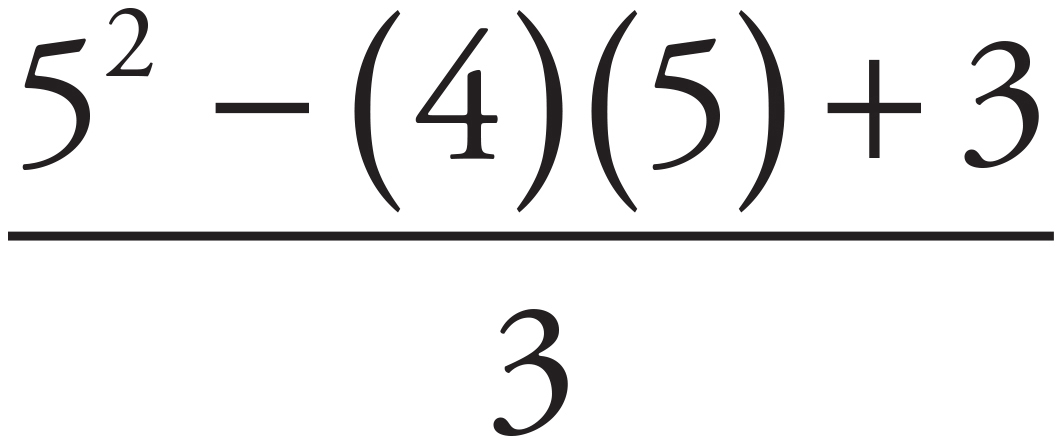 = 2(5 − 1). Solve both sides of the equation to get
= 2(5 − 1). Solve both sides of the equation to get  = 2(4),
= 2(4),  = 8. Because this is not a true statement, eliminate (B). It may not be clear which direction to go, so just pick a direction. Choice (C) becomes
= 8. Because this is not a true statement, eliminate (B). It may not be clear which direction to go, so just pick a direction. Choice (C) becomes  = 2(6 − 1). Solve both sides of the equation to get
= 2(6 − 1). Solve both sides of the equation to get  = 2(5),
= 2(5),  = 10, and 5 = 10. Eliminate (C). Choice (D) becomes
= 10, and 5 = 10. Eliminate (C). Choice (D) becomes  = 2(9 − 1). Solve both sides of the equation to get
= 2(9 − 1). Solve both sides of the equation to get  = 2(8),
= 2(8),  = 16, and 16 = 16. Therefore, the correct answer is (D).
= 16, and 16 = 16. Therefore, the correct answer is (D).
4. C
According to the question, the median income rose $8,000 in a 6-year period. If the trend continues linearly, then the median income would rise again in 6 years. Whenever there are variables in the question, think Plugging In. If x = 6, then the median income would be 57,000 + 8,000 = 65,000. Plug in 6 for x in the answer choices to see which answer equals 65. Choice (A) becomes I = 49 + (8)(6) = 97. Eliminate (A). Choice (B) becomes I = 57 + (8)(6) = 105. Eliminate (B). Choice (C) becomes I = 57 +  (6) = 57 + 8 = 65. Keep (C), but check (D) just in case. Choice (D) becomes I = 49 +
(6) = 57 + 8 = 65. Keep (C), but check (D) just in case. Choice (D) becomes I = 49 +  (6) = 49 + 8 = 57. Eliminate (D). Therefore, the correct answer is (C).
(6) = 49 + 8 = 57. Eliminate (D). Therefore, the correct answer is (C).
5. A
Whenever there are variables in the question and numbers in the answer choices, think Plugging In the Answers. Start with (B). If z = 13, the equation becomes  = 2. Simplify the left side of the equation to get
= 2. Simplify the left side of the equation to get  = 2, 12 − 7.3 = 2, and 4.6 = 2. Eliminate (B). It may not be clear which direction to go from here, so just pick a direction. If you try (A), z = −19, then the equation becomes
= 2, 12 − 7.3 = 2, and 4.6 = 2. Eliminate (B). It may not be clear which direction to go from here, so just pick a direction. If you try (A), z = −19, then the equation becomes  = 2. Simplify the right side of the equation to get
= 2. Simplify the right side of the equation to get 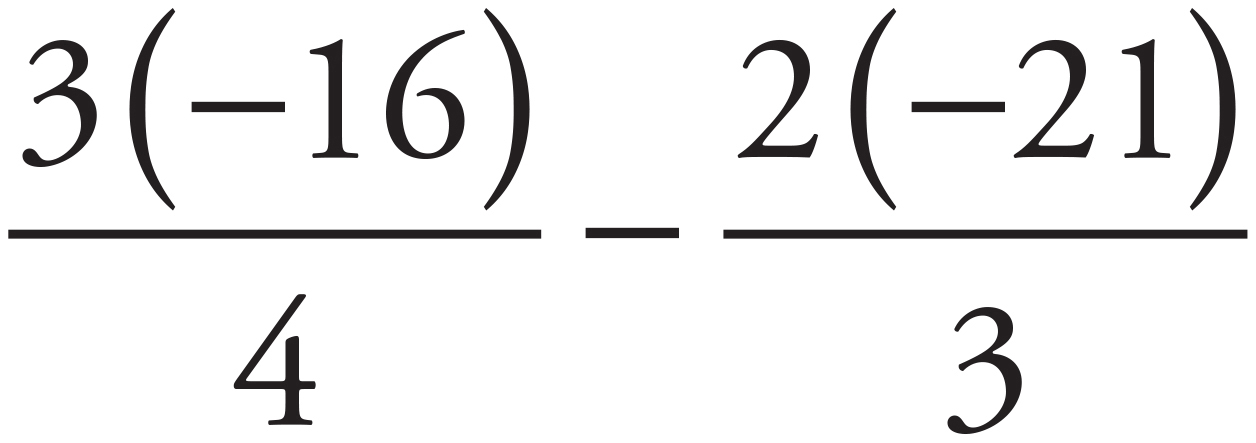 = 2, 3(−4) −[2(−7)] = 2, −12 −[−14] = 2, −12 + 14 = 2, and 2 = 2. Therefore, the correct answer is (A).
= 2, 3(−4) −[2(−7)] = 2, −12 −[−14] = 2, −12 + 14 = 2, and 2 = 2. Therefore, the correct answer is (A).
6. C
The decay rate is not linear; therefore, you can eliminate (B). Because the percentages in (D) are increasing (greater than 1), you can eliminate (D). The black line starts at a count of 5,000 and is decreasing at a higher rate than the grey line. Therefore, the black decay rate (starting at 5,000) must be higher. Therefore, the answer is (C) because it is decreasing at a rate of 10% (0.9 = 1.0 − 0.1), and the grey would be decreasing at a lower rate of 5% (0.95 = 1.0 − 0.05).
7. B
Start by multiplying both sides of the equation by  to get a3 = b ×
to get a3 = b ×  . Square both sides of the equation to get a6 = b2 × ab. Combine like terms to get a6 = ab3 and a5 = b3. Therefore, the correct answer is (B).
. Square both sides of the equation to get a6 = b2 × ab. Combine like terms to get a6 = ab3 and a5 = b3. Therefore, the correct answer is (B).
8. D
According to the question, a bag of apples and 3 cartons of strawberries cost $18. If a = a bag of apples and c = a carton of strawberries, then a + 3c = 18. According to the question, a bag of apples cost 50% more than a carton of strawberries, which can be written as a = 1.5c. Substitute this into the first equation to get 1.5c + 3c = 18. Solve for c to get 4.5c = 18, and c = 4. Therefore, a = 1.5(4) = 6. The correct answer is (D).
9. C
If the website received 24,500 visitors 6 months ago, then three months ago the website received 24,500 × 2 = 49,000 visitors, and today the website is receiving 49,000 × 2 = 98,000 visitors. Whenever there are variables in the question and in the answers, think Plugging In. Every year the number of visitors will increase by a factor of 24 = 16. So, if t = 2, then the population would increase 16 × 16 = 28. Therefore, in 2 years the population would be 98,000 × 28, which, when expressed in thousands, would simply be 98 × 28. Eliminate (A) and (D) because neither of these answers includes 98. In (B), the equation becomes V = 98(22). Eliminate (B). The correct answer is therefore (C).
10. C
If x is the cost of a shirt and y is the cost of a pair of socks, then x + 2y = 24 and 3x + 2y = 32. Whenever there are two equations with the same variables, think simultaneous equations. Stack the two equations on top of each other and subtract them to get:

Solve for x to get x = 4. Plug this value of x back into the bottom equation to get 4 + 2y = 24. Solve for y to get 2y = 20 and y = 10. Therefore, the cost of a shirt and a pair of socks is 4 + 10 = 14. The correct answer is (C).
11. A
Use Bite-Sized Pieces and POE to solve this problem. Multiply both sides by 25 to get 25M = P(51 − I ). Because M is now multiplied by 25, eliminate (C). The correct answer will include 51 in it, so eliminate (B). Divide both sides by P to get
). Because M is now multiplied by 25, eliminate (C). The correct answer will include 51 in it, so eliminate (B). Divide both sides by P to get  = 51 − I
= 51 − I . Subtract 51 from both sides to get
. Subtract 51 from both sides to get  − 51 = −I
− 51 = −I . In order to isolate I, both sides will need to be divided by
. In order to isolate I, both sides will need to be divided by  . Choice (D) multiplies by
. Choice (D) multiplies by  instead. Eliminate (D). The correct answer is (A).
instead. Eliminate (D). The correct answer is (A).
12. B
Start by converting the radians to degrees by multiplying the radian values by  :
:  = 135 and
= 135 and  = 225. Therefore, the central angle AOB is between 135 and 225 degrees. The value of 180 degrees, which is half the circle, is between these two values, so calculate the arc length if the central angle is 180 degrees. The formula for the circumference of a circle is C = 2πr. Therefore, the full circumference of circle O can be calculated as C = 2π(4) = 8π. If the central angle were 180 degrees, then the length of arc AB would be half that, or 4π. The correct answer is (B).
= 225. Therefore, the central angle AOB is between 135 and 225 degrees. The value of 180 degrees, which is half the circle, is between these two values, so calculate the arc length if the central angle is 180 degrees. The formula for the circumference of a circle is C = 2πr. Therefore, the full circumference of circle O can be calculated as C = 2π(4) = 8π. If the central angle were 180 degrees, then the length of arc AB would be half that, or 4π. The correct answer is (B).
13. B
Because John’s baseball card collection decreases in value over time, and his silver collection increases over time, the 500(1.05)t of the equation must be related to his silver collection, and the 600(0.95) part of the equation must be related to his baseball card collection. Use POE to find the answer. The current value of his silver collection, at t = 0, is 500, and the current value of his baseball card collection is 600(0.95)
part of the equation must be related to his baseball card collection. Use POE to find the answer. The current value of his silver collection, at t = 0, is 500, and the current value of his baseball card collection is 600(0.95) . For this reason, eliminate (A). Given that t is time in years, the baseball card collection is losing 5% in value every 2 years. Eliminate (C) for this reason. According to the equation, the silver collection gains 5% every year, and the baseball collection loses 5% every 2 years, so eliminate (D). Therefore, the total value of the baseball and silver collection will not remain constant over time. The correct answer is therefore (B).
. For this reason, eliminate (A). Given that t is time in years, the baseball card collection is losing 5% in value every 2 years. Eliminate (C) for this reason. According to the equation, the silver collection gains 5% every year, and the baseball collection loses 5% every 2 years, so eliminate (D). Therefore, the total value of the baseball and silver collection will not remain constant over time. The correct answer is therefore (B).
14. 13
Plug in the numbers given in the function to get f(4) = 3(4) = 12 and g(2) = 2 − 3 = −1. Therefore, f(4) − g(2) = 12 − (−1) = 13. The correct answer is 13.
15. 40
According to the question, males make up  of the class, which means that females make up
of the class, which means that females make up  of the class. The difference between males and females is 8, which is equal to
of the class. The difference between males and females is 8, which is equal to  −
−  =
=  of the class. Therefore, the number of students in the class can be calculated as
of the class. Therefore, the number of students in the class can be calculated as  (total) = 8. Solve for the total to get a total of 40 students. The correct answer is 40.
(total) = 8. Solve for the total to get a total of 40 students. The correct answer is 40.
16. 4
According to the question, c is at least 3 times the value of d. This can be translated as c ≥ 3d, and the difference between c and d is no more than 8, which can be translated as c − d ≤ 8. To find the greatest value of d, plug in values for d. It may help to create a chart like the following:
|
d |
c ≥ 3d |
c − d ≤ 8 (plug in the smallest value of c). |
|
1 |
c ≥ 3 |
3 − 1 = 2 |
|
2 |
c ≥ 6 |
6 − 2 = 4 |
|
3 |
c ≥ 9 |
9 − 3 = 6 |
|
4 |
c ≥ 12 |
12 − 4 = 8 |
Therefore, the smallest possible value of d is 4. The correct answer is 4.
17. 2.2
First, put the values given in the problem into the equations. Because displacement is 22 meters and initial velocity is 5 meters, the first equation becomes 22 = 15t + 0.5at2. The second equation becomes 5 = 15 + at. Working with the second equation, subtract 15 from both sides to get −10 = at, which means that a = 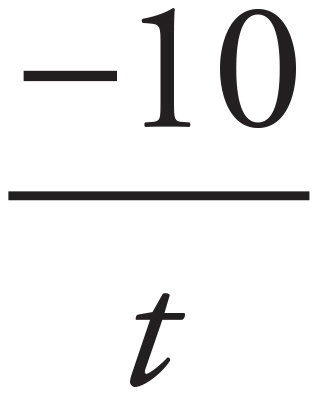 . Next, substitute this value for a into the first equation to get 22 = 15t + 0.5
. Next, substitute this value for a into the first equation to get 22 = 15t + 0.5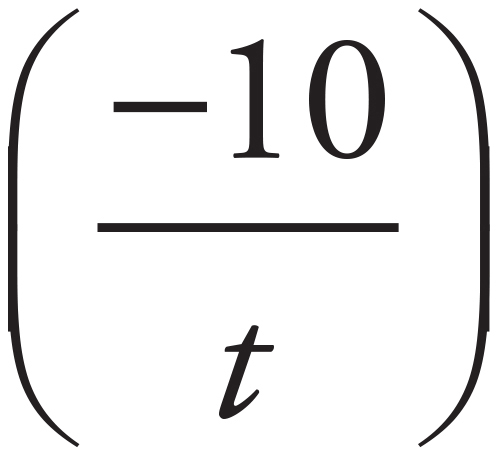 (t2). Simplify the equation to get 22 = 15t + 0.5(−10t). Distribute the 0.5 to get 22 = 15t − 5t. Solve for t to get 22 = 10t and t = 2.2. The correct answer is 2.2.
(t2). Simplify the equation to get 22 = 15t + 0.5(−10t). Distribute the 0.5 to get 22 = 15t − 5t. Solve for t to get 22 = 10t and t = 2.2. The correct answer is 2.2.
Section 4—Math (Calculator Allowed)
1. A
According to the question, the proton traveled through medium A at 100,000 meters in 5 milliseconds, which is equal to a velocity of 20,000 meters per millisecond. Therefore, the velocity through medium B can be calculated as 20,000 ÷ 2 = 10,000 meters per millisecond. The correct answer is therefore (A).
2. A
Plugging In the Answers with negative fractions could take awhile, so solve the inequality. Add 5 to both sides to get 6x < 7 + 15x. Subtract 15x from both sides to get −9x < 7. Remember when dividing by a negative number, flip the inequality sign. Solve for x to get x > − . The only value that is less than this is −
. The only value that is less than this is − . The correct answer is (A).
. The correct answer is (A).
3. A
Whenever the question includes variables and the answers are numbers, think Plugging In the Answers. Start with (B). If r = −6, the equation becomes −6 + 22 = 3(−6) − 26 + 62. Simplify the equation to get 16 = −18 − 26 + 36 and 16 = −8. Eliminate (B). It may not be clear which direction to go, so just pick one. In (A), r = −8 and the equation becomes −8 + 22 = 3(−8) − 26 + (−8)2. Simplify the equation to get 14 = −24 − 26 + 64 and 14 = 14. The correct answer is (A).
4. D
Use POE. The term at least means ≥. On this basis, eliminate (A) and (C). To calculate the total number of hours worked at the community center, multiply the number of hours worked per day by the number of days. This calculation is 7.5c. Likewise, to calculate the total number of hours spent removing street litter, multiply the number of hours worked per day by the number of days. This calculation is 4l. Therefore, eliminate (B). The correct answer is (D).
5. D
The median is the middle number when the numbers are listed in order from low to high. In order for the median length to be 15, x must be in the middle of the list of numbers. So, lined up from low to high, the numbers are 6, 9, 9, x, 36, and 39. There is no one middle number, so the median is the average of the middle two. Therefore, 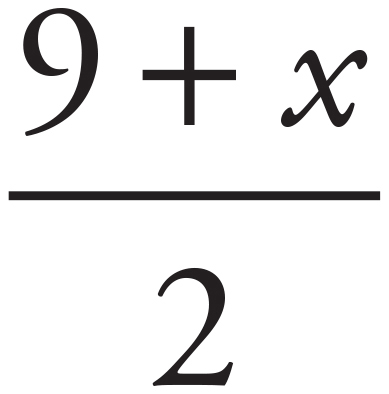 = 15. Solve for x to get 9 + x = 30 and x = 21. To find the mean length, add all of the numbers together and divide by 6:
= 15. Solve for x to get 9 + x = 30 and x = 21. To find the mean length, add all of the numbers together and divide by 6:  = 20. The correct answer is (D).
= 20. The correct answer is (D).
6. A
According to the question, 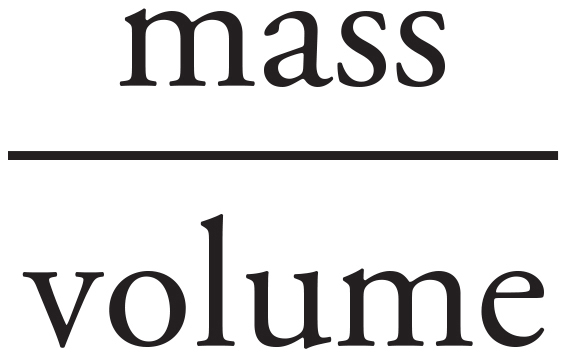 . Substitute the numbers given into the equation to get 19.3 =
. Substitute the numbers given into the equation to get 19.3 =  . Solve for mass and get 96.5 grams. Use the following proportion to convert mass into ounces:
. Solve for mass and get 96.5 grams. Use the following proportion to convert mass into ounces:  . Cross-multiply to get 28.3x = 96.5. Solve for x to get x ≈ 3.41. The correct answer is (A).
. Cross-multiply to get 28.3x = 96.5. Solve for x to get x ≈ 3.41. The correct answer is (A).
7. D
Use POE to solve this question. In (A), 0.10 × 200,000 = 20,000. However, you know from the information given that far more scientists believe the mass extinction to be caused by the Chicxulub Asteroid. Therefore, eliminate (A). In (B), 0.25 × 200,000 = 50,000. Again, far more scientists believe the mass extinction to be caused by the Chicxulub Asteroid. Eliminate (B). In (C), 0.50 × 200,000 = 100,000. Again, the number of scientists who believe the mass extinction to be caused by the Chicxulub Asteroid is much higher. Therefore, the answer must be (D).
8. D
Whenever there are variables in the question and in the answer choices, think Plugging In. If x = 52, then the output is 385 + 2(42) = 385 + 84 = 469 computer chips. Plug 52 in for x in the answers to see which answer equals 469. Choice (A) becomes C(52) = 42(52 − 50) + 385 = 422 + 385 = 2,149. Eliminate (A). Choice (B) becomes C(52) = 5242 + 385. This number is huge! Eliminate (B). Choice (C) becomes C(52) = 42(52) + 385 = 2,184 + 385 = 2,569. Eliminate (C). Therefore, the answer must be (D).
9. C
Multiply the right side of the equation by  to get
to get  . Because the denominators are now the same, 6(t + 2) = 100 − 5t + 44. Distribute the 6 to get 6t + 12 = 100 − 5t + 44. Combine like terms to get 6t + 12 = 144 − 5t and 11t + 12 = 144. Solve for t to get 11t = 132 and t = 12. The correct answer is (C).
. Because the denominators are now the same, 6(t + 2) = 100 − 5t + 44. Distribute the 6 to get 6t + 12 = 100 − 5t + 44. Combine like terms to get 6t + 12 = 144 − 5t and 11t + 12 = 144. Solve for t to get 11t = 132 and t = 12. The correct answer is (C).
10. B
The question is asking about changing the format of the equation for a parabola to the vertex form of the equation. The vertex form of a parabola is y = a(x − h)2 + k, where (h, k) denotes the vertex of the parabola. Only (B) is written in this format.
11. C
Whenever there are variables in the question and in the answers, think Plugging In. If m = 2, then Taylor has written 23 × 2 = 46 words. Given that each page has 800 words, Taylor has written far less than a page, which means he has 699 pages plus a fraction of a page left. Plug in 2 for m in the answers to see which answer yields 699 plus a fraction. Choice (A) becomes p(m) =  =
=  . Eliminate (A). Choice (B) becomes p(m) =
. Eliminate (A). Choice (B) becomes p(m) =  =
= 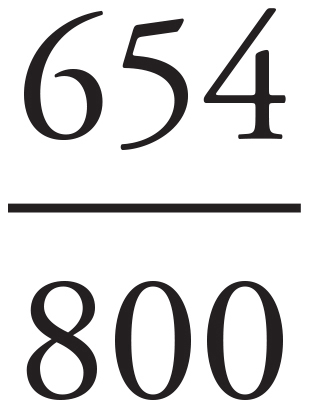 , which is less than a page. Eliminate (B). Choice (C) becomes p(m) = 700 −
, which is less than a page. Eliminate (B). Choice (C) becomes p(m) = 700 −  = 700 −
= 700 −  = 699.9425. This is possible. Keep (C), but check (D) just in case. Choice (D) becomes p(m) = 700 −
= 699.9425. This is possible. Keep (C), but check (D) just in case. Choice (D) becomes p(m) = 700 −  = 700 −
= 700 −  ≈ 700 − 17.39 ≈ 682.61. Eliminate (D), and you’re left with (C).
≈ 700 − 17.39 ≈ 682.61. Eliminate (D), and you’re left with (C).
12. B
The line shown includes the points (−3, 1) and (−1, 2). The equation for the slope of a line is m =  , which for the line shown can be calculated as m =
, which for the line shown can be calculated as m = 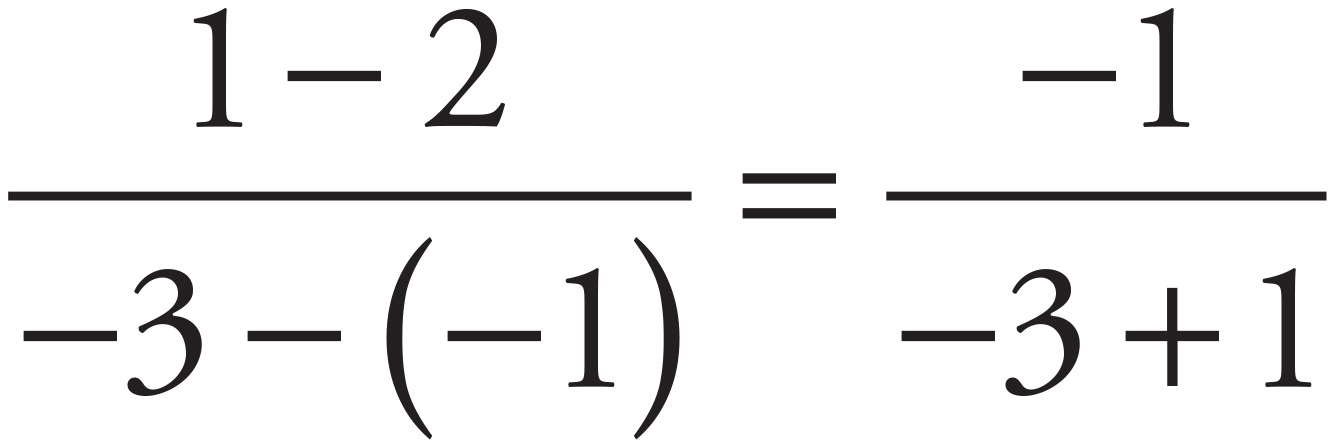 =
=  . Parallel lines have the same slope, so eliminate (A) and (D), which do not have a slope of
. Parallel lines have the same slope, so eliminate (A) and (D), which do not have a slope of  . Plug the point (3, −2) into the remaining answer choices to see which one works. Choice (B) becomes −2 =
. Plug the point (3, −2) into the remaining answer choices to see which one works. Choice (B) becomes −2 =  (3) −
(3) −  , or −2 =
, or −2 =  −
−  . This becomes −2 = −
. This becomes −2 = −  , which is true.
, which is true.
13. C
A quick look at the answer choices shows that the population of people in poverty in 2008 must have been 50,000. Whenever there are variables in the question and in the answers, think Plugging In. If m = 12, then the population of those in poverty should be 50,000 ÷ 2 = 25,000. Plug 12 in for m in the answers to see which answer equals 25,000. Choice (A) becomes f(m) = 50,000 −  (12) = 50,000 − 6 = 49,994. Eliminate (A). Choice (B) becomes f(m) = 50,000 −
(12) = 50,000 − 6 = 49,994. Eliminate (A). Choice (B) becomes f(m) = 50,000 −  = 50,000 − 0.5 = 49,999.5. Eliminate (B). Choice (C) becomes f(m) = 50,000 −
= 50,000 − 0.5 = 49,999.5. Eliminate (B). Choice (C) becomes f(m) = 50,000 −  = 50,000
= 50,000 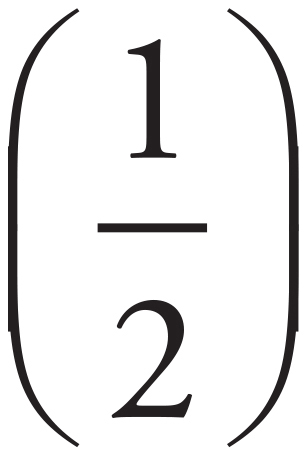 = 25,000. Keep (C), but check (D) just in case. Choice (D) becomes f(m) = 50,000 − 12
= 25,000. Keep (C), but check (D) just in case. Choice (D) becomes f(m) = 50,000 − 12 ≈ 50,000 − 3.45 = 49,996.55. Eliminate (D), and you’re left with (C).
≈ 50,000 − 3.45 = 49,996.55. Eliminate (D), and you’re left with (C).
14. B
The equation to find the slope of a line is m = 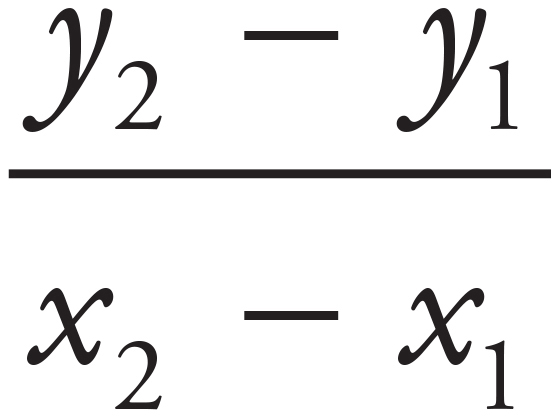 . The slope for the line shown can be calculated as 40 =
. The slope for the line shown can be calculated as 40 = 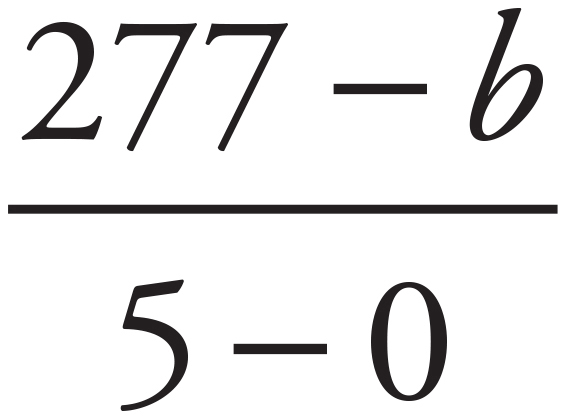 . Simplify the fraction to get 40 =
. Simplify the fraction to get 40 =  . Multiply both sides of the equation by 5 to get 200 = 277 − b. Solve for b to get −77 = −b and 77 = b. The correct answer is (B).
. Multiply both sides of the equation by 5 to get 200 = 277 − b. Solve for b to get −77 = −b and 77 = b. The correct answer is (B).
15. D
Whenever there are variables in the question and in the answers, think Plugging In. If x = 4, then y = 42 + 4 − 20 = 16 + 4 − 20 = 0 and  = 0. Plug 4 in for x in the answers to see which answer equals 0. Choice (A) becomes
= 0. Plug 4 in for x in the answers to see which answer equals 0. Choice (A) becomes  =
= 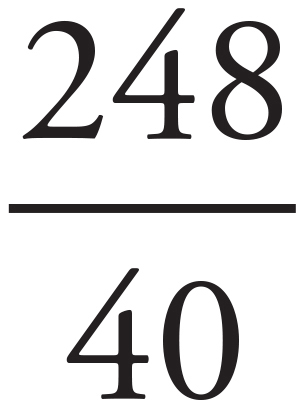 . Eliminate (A). Choice (B) becomes
. Eliminate (A). Choice (B) becomes  =
= 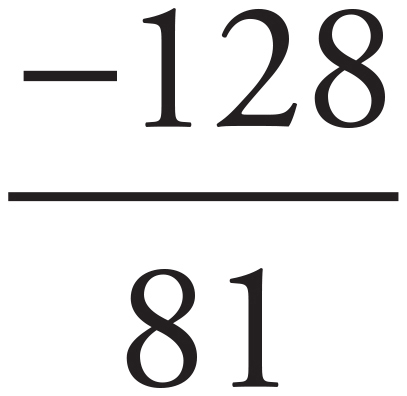 . Eliminate (B). Choice (C) becomes 42 − (8)(4) − 15 = 16 − 32 − 15 = −31. Eliminate (C), and you’re left with (D).
. Eliminate (B). Choice (C) becomes 42 − (8)(4) − 15 = 16 − 32 − 15 = −31. Eliminate (C), and you’re left with (D).
16. A
Start by using POE. The more pictures Squared Up frames, the greater its profits will be. Therefore, the correct answer must include a > symbol. Eliminate (B) and (D). Start with the remaining answers. According to (C), Squared Up would turn a profit if it framed 13 pictures. Profit = Revenue − Expenses. On 13 pictures, Squared Up would make 13 × 61 = 793 in revenue. The expenses to frame these pictures can be calculated as 13(38 + 5) + 720 = 13(43) + 720 = 559 + 720 = 1,279. Because expenses exceed revenues, Squared Up will not make a profit if it framed only 13 pictures. Eliminate (C), and you’re left with (A).
17. B
The average amount spent per person in a household can be calculated as the total amount spent on groceries divided by the number of people in the household. The survey provided no data on the number of people in each household. Therefore, the correct answer is (B).
18. B
Use POE to solve. Because no data is provided on meals had at restaurants, eliminate (A). According to the question, as household income increased, grocery spending decreased. Therefore, (B) is a possible answer. While there is a connection between household income and grocery spending, it is not clear from the data that it is a causal connection. Therefore, eliminate (C). The data focuses just on Florida and therefore no inferences can be made about grocery spending in the United States. Eliminate (D), and you’re left with (B).
19. A
Whenever there are two equations with the same variables, think simultaneous equations. First, rewrite both equations so that the variables are on one side of the equation. The first equation becomes 3x − 96 = 4y and 3x − 4y = 96. The second equation becomes 10x + 2y = 90. Multiply this second equation by 2 to get 20x + 4y = 180. Place the two equations on top of each other and add them:
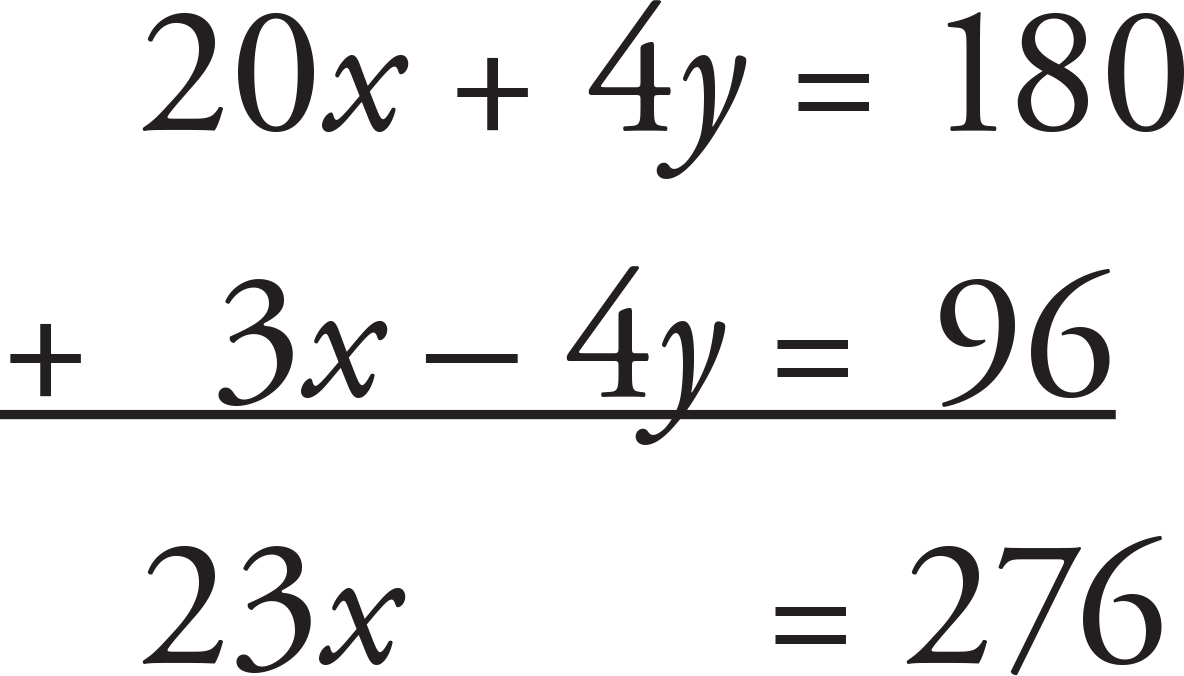
Solve for x to get x = 12. Plug 12 in for x in the second equation to get 3(12) − 4y = 96. Solve for y to get 36 − 4y = 96, −4y = 60, and y = −15. Therefore, 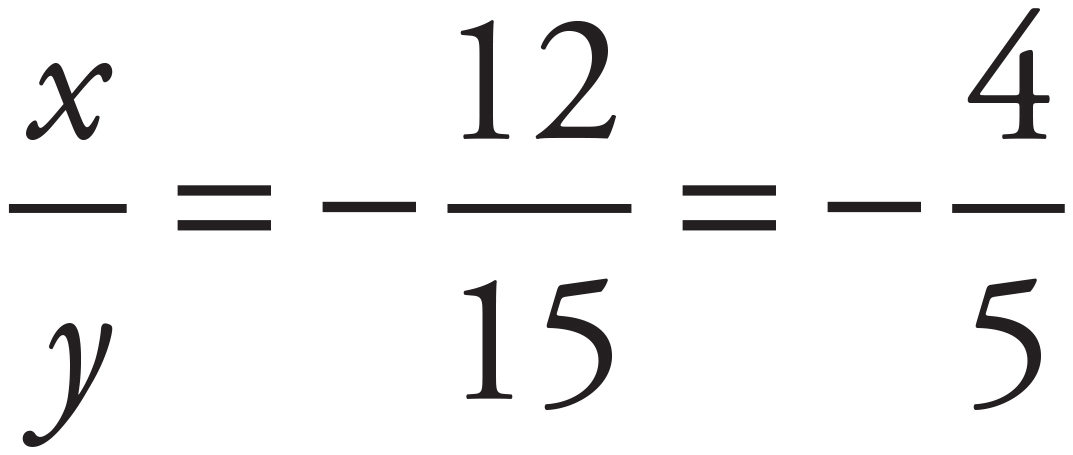 . The correct answer is (A).
. The correct answer is (A).
20. C
The mean file size of a single song is 0.022 × 1,024 = 22.528 megabytes. The file size of all the songs Larissa uploaded is 40,000 × 22.528 = 901,120 megabytes. The upload time in seconds is 7.5 × 60 × 60 = 27,000 seconds. Therefore, the upload time in megabytes per second is  ≈ 33.37. The correct answer is (C).
≈ 33.37. The correct answer is (C).
21. D
2015 is 3 years after 2012. Therefore, y = 3, and the function becomes c(3) = 17(3) + 112 = 51 + 112 = 163. Given that 20 additional cheetahs joined, the total population is 163 + 20 = 183. The correct answer is (D).
22. B
Start by figuring out the median number of cars owned in all 5 boroughs. To do this, find the total number of cars and then see where the middle of the list is:
|
Number of Cars |
Total in All 5 Boroughs |
|
Zero |
4,160 |
|
One |
2,320 |
|
Two |
1,140 |
|
Three |
380 |
The median number is at 4 million cars, which is 0 cars. Next, add up the number of residents who live in Manhattan and own more than 0 cars:
|
Number of Cars |
Manhattan |
|
One |
480 |
|
Two |
320 |
|
Three |
80 |
|
Total |
880 |
The question can be translated as 880,000 is what percent of 8,000,000? Do math translation to get the following equation: 880,000 =  × 8,000,000. Solve for x to get x = 11. The correct answer is (B).
× 8,000,000. Solve for x to get x = 11. The correct answer is (B).
23. D
Whenever there are two equations with two variables, think simultaneous equations. Rewrite the first equation as 8s − 4t = 17 and the second equation as −5s + 6t = 4. Stack the two equations on top of each other and add them:

Multiply the entire equation by 2 to get 6s + 4t = 42. The correct answer is (D).
24. A
The vertex form of a parabola is y = a(x − h)2 + k, where (h, k) stands for the vertex. Start by converting the parabola equation into its vertex form by completing the square. The equation becomes y − 6 = x2 − 8x + 22 − 6. Simplify the equation to get y − 6 = x2 − 8x + 16. Factor the right side of the equation to get y − 6 = (x − 4)2. Move the 6 over to get y = (x − 4)2 + 6. Therefore, the vertex of the parabola is (4, 6). The equation of a circle is (x − h)2 + (y − k)2 = r2, where the center of the circle is (h, k). Therefore, the equation of a circle centered at (4, 6) is (x − 4)2 + (y − 6)2 = r2. Expand the circle equation to get x2 − 8x + 16 + y2 − 12y + 36 = r2. Rewrite the equation of the circle given in the problem as x2 − 8x + y2 + ky = 172. Therefore, ky = −12y and k = −12. The correct answer is (A).
25. C
Use POE. Be careful in reading the y-axis. The information provided is related to the rate of increase not the population. Given that no information on the actual population is given, eliminate (B) and (D). According to the graph, the population of H2 increased by 300 bees in 2001, but only increased by 250 bees in 2003. In other words, the population increased albeit at a slower rate during the 10 years. For this reason eliminate (A). The correct answer is (C).
26. D
Use POE to solve this question. Given that y is the number of phytoplankton over time, eliminate (A). According to the question, prior to 2007 there were no phytoplankton in the lake, so eliminate (B). According to the problem, k represents the number of months the population was introduced. Therefore, the rate of increase in a month would be equal to 6.23 . Eliminate (C). The correct answer is (D).
. Eliminate (C). The correct answer is (D).
27. D
Look for years where the line of best fit gives an easy-to-approximate number for the area of square miles. 1970 correlates with approximately 12 million for the decrease in area of square miles, and 2000 correlates with 10 million. Subtract these values for a difference of 2 million. Then divide by 30, because there is a 30-year difference between 1970 and 2000. The answer is roughly 66,000, which is (D).
28. 24
In a circle equation in the form (x − h)2 + (y − k)2 = r2, the center is (h, k) and the radius is r. In the given equation, r2 = 144. Take the square root of both sides to get r = 12. The diameter equals 2r, so the diameter is 2(12) = 24. The correct answer is 24.
29. 1
In order for p(x) to equal 0, the numerator must equal 0. If (x + 4) = 0 or (x − 4) = 0, then x = ±4. However, x cannot equal −4 because that would make the denominator 0. Therefore, the only value that will make the function 0 is when x = 4. The correct answer is 1.
30. 405
Under Package A, Jason earned $10,000 + (.01)(110)(30,000) = $43,000. The question states that had Jason chosen Package B, he would have earned 43,000 + 1,550 = 44,550. Given that Package B is comprised of a fixed price per car × the number of cars sold, and Jason sold 110 cars, the fixed amount earned for each car can be calculated as 44,500 ÷ 110 = 405. The correct answer is 405.
31. 40
There is enough information given to see how much Jason would earn with Package B. Multiply the amount he earns per car by the number of cars: 725 × 80 = 58,000. Now write an equation for Package A: A = $10,000 + (.015)(80)x, where x is the mean sales price of the cars sold. You can set this equation equal to 60,000 because Package A equals Package B. The answer is $40,000. Since the question is asking for thousands, 40 should be gridded in.
